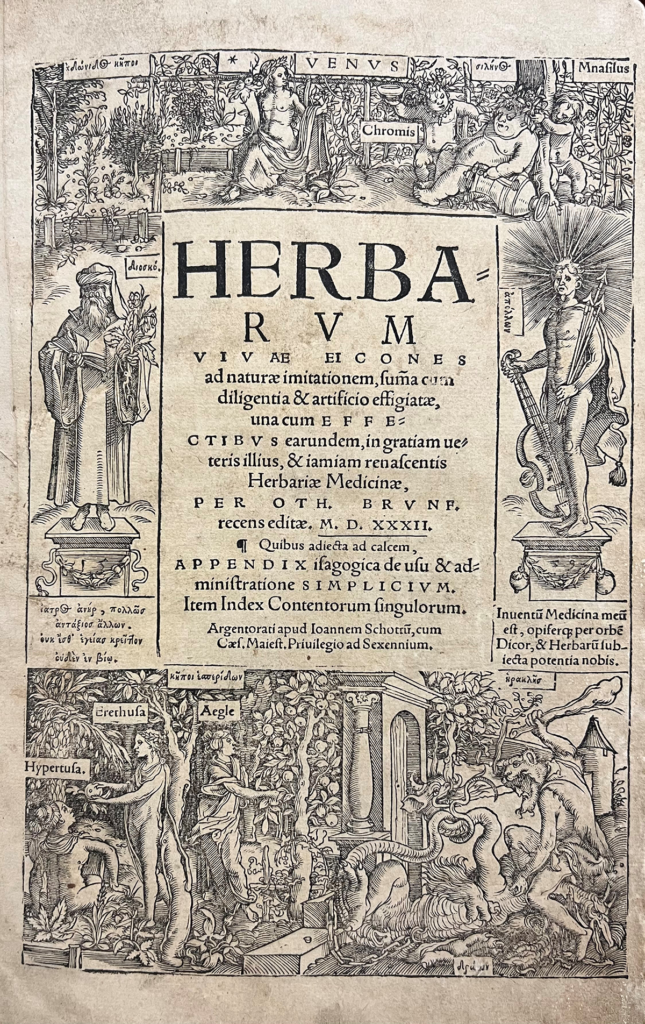 Botany grew, in part, out of the medieval herbal tradition. For centuries plants had been written about principally out of interest in their usefulness as foodstuffs and medicines for humans and their livestock. The scientific revolution of the 16th and 17th centuries, with its new focus on scientific observation and experiments, led to the emergence of modern science, with new disciplines including biology, chemistry, and astronomy. The term ‘botany’ began to be used in the 1640s, describing the branch of science concerned with the study of taxonomic, morphological, and ecological aspects of plants. From Otto Brunfels, one of the founders of botany in the 16th century, to 19th century botanical handbooks, the Cathedral Library has plenty of plants in the leaves of its books.
Botany grew, in part, out of the medieval herbal tradition. For centuries plants had been written about principally out of interest in their usefulness as foodstuffs and medicines for humans and their livestock. The scientific revolution of the 16th and 17th centuries, with its new focus on scientific observation and experiments, led to the emergence of modern science, with new disciplines including biology, chemistry, and astronomy. The term ‘botany’ began to be used in the 1640s, describing the branch of science concerned with the study of taxonomic, morphological, and ecological aspects of plants. From Otto Brunfels, one of the founders of botany in the 16th century, to 19th century botanical handbooks, the Cathedral Library has plenty of plants in the leaves of its books.
One of the early pioneers of botany to be found in the Cathedral Library is the German theologian and botanist Otto Brunfels, whose ‘Herbarum vivae eicones’ (1530-1536) represented a new way of describing and drawing plant specimens from life – one of the defining features of botanical science. Herbals such as John Gerard’s ‘Herball or general historie of plants’ (1597), which focused on the uses, properties or ‘virtues’ of plants remained popular, but made minimal attempts at classification and scientific observation.
In the late 16th century, the Swiss brothers Jean and Gaspard Bauhin used their observations of thousands of plants to develop a new system of taxonomy, defining botanical species based on the natural affinities of plants. Their work, republished in the ‘Historia plantarum universalis’ (1650), foreshadowed and inspired that of the great Swedish taxonomist Carl Linneaus in the mid-18th century, whose binomial system for classifying and naming organisms remains the basis of modern scientific naming.
Field observation was key to the early botanists, but improvements in microscope technology and availability in the mid-17th century added a new level of detail to the understanding of plant biology. In ‘The anatomy of plants’ (1679) the leading English plant anatomist Nehemiah Grew was able to produce the first descriptions of microscopic pollen.
Earlier works of botany are frequently hefty tomes, often written in Latin – the scientific language of Europe. The influential English naturalist John Ray had produced ‘Catalogus plantarum Angliae’ (1670), a compendious catalogue of English plants, based on years of travels. It was portable, so suitable for use in the field, but it was written in Latin so its audience was limited. By the early 19th century a new crop of convenient practical handbooks emerged for a popular audience, written not in Latin, but in the language spoken by the majority, including the dinky ‘Practical Introduction to Botany’ (1817) produced by the well-known English cleric and naturalist William Bingley.
Join the Cathedral Librarian on Wednesday 16 March at our British Science Week Library & Archive Spotlight event to discover more about Otto Brunfels’ ‘Herbarum’.